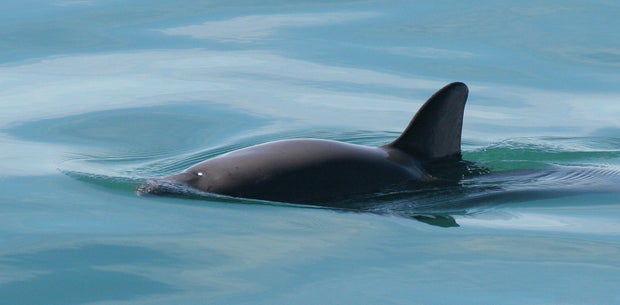The variety of Mexico’s critically endangered vaquita marina porpoises sighted within the Gulf of California fell to between 6 and eight this 12 months, researchers stated Tuesday, although it is doable that a number of the creatures could have moved elsewhere within the Gulf, the one place on the planet the place they dwell.
Vaquitas are the world’s smallest porpoise and probably the most endangered marine mammal on the planet.
Last 12 months, consultants on a sighting expedition estimated they noticed from 10 to 13 of the tiny, shy, elusive porpoises throughout practically two weeks of crusing within the Gulf, often known as the Sea of Cortez.
But this 12 months, the conservation group Sea Shepherd stated an analogous expedition carried out throughout three weeks in May sighted solely a few half dozen, although the search was not as intensive as final 12 months’s. More troubling, no child vaquitas have been seen this 12 months.
“Unlike 2023, no just lately born calves have been seen, however a wholesome juvenile was seen,” Sea Shepherd stated in a press release.
However, about half the sightings final 12 months occurred outdoors and simply west of the vaquitas’ unique safety zone, a closely patrolled space within the Gulf the place all fishing is prohibited, although some nonetheless happens illegally.
Paula Olson/NOAA
Experts aren’t precisely certain why vaquitas would possibly like the realm simply outdoors the protected zone, however this 12 months’s expedition focused on areas contained in the zone.
Because they’re so small and elusive, many instances the vaquitas can solely be seen from distant by way of highly effective binoculars, and so such sightings are categorized as possible or probably. Thus, the numbers are expressed in possible “ranges” of the actual determine.
The mammals additionally emit “clicks” that may be heard by way of acoustic monitoring units.
“While these outcomes are worrying, the realm surveyed represents solely 12% of the whole space the place vaquitas have been noticed in 2015,” stated Dr. Barbara Taylor, the researcher who led the examine. “Since vaquitas transfer freely throughout the vaquita refuge, we should lengthen the survey utilizing acoustic detection to find out the place the vaquitas are going.”
There are plans to just do that. But in accordance with the earlier report, “fishermen have begun eradicating the acoustic units (CPODs) used to document vaquita clicks. The information recorded on every gadget is misplaced, and it’s costly to exchange the stolen CPODs.”
“Unless enforcement of the fishing ban is efficient and the theft of apparatus is stopped, acoustic monitoring can not acquire information because it has up to now,” the report acknowledged.
A species in danger
Last 12 months’s report had raised hopes for the species, which lives nowhere else and can’t be captured, held or bred in captivity. An try was made in 2018 to seize some vaquitas and assist them breed in captivity, however the first porpoise captured was “simply too confused from the expertise” and needed to be launched, CBS News beforehand reported.
This 12 months’s report was one other piece of continued unhealthy information for the species. Illegal gillnets have trapped and killed vaquitas for many years; the reported inhabitants has declined from practically 600 vaquitas in 1997.
Fishermen set the nets to catch totoaba, a fish whose swim bladder is taken into account a delicacy in China and may fetch 1000’s of {dollars} per pound. The measurement of the nets is about the identical measurement as a vaquita’s head, CBS News reported, making it straightforward for them to change into ensnared within the mesh.
While the Mexican authorities has made some efforts to cease the web fishing — like sinking concrete blocks with hooks to snag nets within the protected zone — the fishermen nonetheless seem to have the higher hand, setting unlawful nets recurrently and even sabotaging monitoring efforts.
Alex Olivera, the Mexico consultant for the Center for Biological Diversity, stated “vaquitas reproduce so slowly that restoration is unattainable with out assist, and their very survival stays in grave doubt.”
SAUL LOEB
“Vaquitas face a severe menace of extinction from harmful gillnets of their habitat and the Mexican authorities’s lax enforcement of protecting laws,” Olivera stated, noting “it is essential” that enforcement be stepped up now.
Olivera, who was not a part of the expedition, beforehand estimated that “even in a gillnet-free habitat, it can take about 50 years for the inhabitants to return to the place it was 15 years in the past.”
A scientist advised CBS News in 2018 that eradicating gillnets may assist shield the species.
“If we are able to completely make sure that these underwater gillnets aren’t in a spot the place the remaining animals are, they might survive,” the scientist defined. “They simply want an opportunity.”
President Andrés Manuel López Obrador’s administration has largely declined to spend cash to compensate fishermen for staying out of the vaquita refuge and cease utilizing gillnets, or monitor their presence or the areas they launch from.
Sea Shepherd has been working within the Gulf alongside the Mexican Navy to discourage unlawful fishing within the protected space. The authorities’s safety efforts have been uneven, at finest, and in addition typically face violent opposition from native fishermen.










































